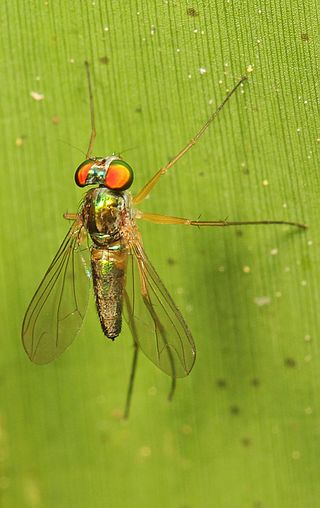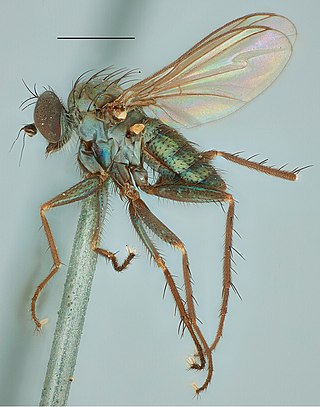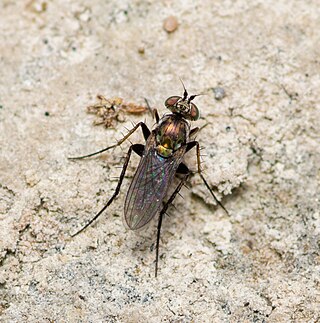
Argyra is a genus of flies in the family Dolichopodidae. The name "Argyra" comes from the Greek word for "silver", referring to the silver pruinescence found on the males of many of the species.

Amblypsilopus is a genus of flies in the family Dolichopodidae. It is a large genus, with about 350 species recorded. However, it is possibly polyphyletic.
Amesorhaga is a genus of flies in the family Dolichopodidae. All species in the genus are from the Oriental realm.

Asyndetus is a genus of flies in the family Dolichopodidae. There are more than 100 species described for the genus, distributed worldwide.
Chaetogonopteron is a genus of flies in the family Dolichopodidae.

Chrysosoma is a genus of flies in the family Dolichopodidae. It is a large genus, with more than 200 species distributed in the Old World and Oceania.

Diaphorus is a genus of flies in the family Dolichopodidae. Lyroneurus was formerly considered a subgenus, but is now either treated as a synonym of Chrysotus or treated as a distinct genus.
Hadromerella is a genus of flies in the family Dolichopodidae. It contains two species known from Java in Indonesia.

Medetera is a large genus of flies in the family Dolichopodidae. It includes about 350 species worldwide. The adults are commonly found resting on vertical surfaces such as tree trunks, on which they have a characteristic vertical upright stance. Because of this stance, they are sometimes known as "woodpecker flies". Medetera adults are predators of soft-bodied arthropods, while the larvae are predators of bark beetle larvae.

Paraclius is a genus of flies in the family Dolichopodidae. It is currently considered a polyphyletic assemblage of species.

Pelastoneurus is a genus of flies in the family Dolichopodidae.

Tachytrechus is a genus of long-legged flies in the family Dolichopodidae.

Thinophilus is a genus of flies in the family Dolichopodidae. It includes about 146 described species distributed worldwide. Most species of the genus are found in coastal habitats, while a few species are found in freshwater habitats.
Trigonocera is a genus of flies in the family Dolichopodidae. It is known from the Afrotropical, Oriental and Palaearctic realms.
Urodolichus is a genus of fly in the family Dolichopodidae. It is known from the Afrotropical realm, Indomalayan realm and Australasian realm. It has been placed in either Rhaphiinae or Diaphorinae, though Grichanov & Brooks (2017) consider the genus to be incertae sedis within the family Dolichopodidae.

Hydrophorinae is a subfamily of flies in the family Dolichopodidae. Several molecular phylogenetic analyses of the family have found evidence that the subfamily in its current sense is polyphyletic.

Peloropeodinae is a subfamily of flies in the family Dolichopodidae. In some classifications, the genera of the subfamily are included in Sympycninae. According to a molecular phylogenetic analysis of the family Dolichopodidae by Germann et al. (2011), the subfamily is polyphyletic.

Sympycninae is a subfamily of flies in the family Dolichopodidae. In some classifications, this subfamily includes the genera of the subfamilies Peloropeodinae and Xanthochlorinae.












